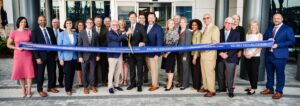Innovation in Rehabilitation Technology

Back to physical health resource hub
Brooks regularly works with leading healthcare technology and equipment companies to help develop and test new tools that will benefit our patients. Brooks will also vet and acquire new technology purchases through our Innovative Clinical Technology Committee. Clinicians throughout our system can submit a request to the committee to access capital funds in order to pursue new and innovative technologies. The committee will work with the clinician to determine if the technology is beneficial and, if so, purchase it for use throughout Brooks.
Bob McIver, PT, DPT, NCS, director of Brooks Clinical Technology and Wellness Programming, shares some of the latest technology in and around Brooks:
Brooks Home Health Technology Kit
Traditionally, a lot of technology is not easily available for home health because it’s not very portable and if it is portable, it’s usually quite expensive. We have functional electrical stimulation (FES) bikes that we use in our facilities that use electrical stimulation to contract the muscles in the arms or legs in a segmental fashion that represents a specific type of function. Historically, it really hasn’t been available for home health.
What we’ve done through our technology department is take the tablet and the stimulator from one of the cycles and package them into a portable pack that can then go into the home with a home health clinician. Now the patient may not be cycling, but they can continue their electrical stimulation in many different ways and it gives the home health therapist a new piece to work with. We’re in discussions with the manufacturer, who has been receptive, about creating this more affordable and portable product.
Virtual Reality Apps
Brooks has partnered with a software engineering firm that develops virtual reality applications and simulations for workforces. With patients using a virtual reality headset, we’ve developed or are developing:
- “Brook Saber,” based on a popular Oculus game called Beat Sabre, where you’re hitting boxes coming at you with two light sabers.
- A wheelchair mobility package, which uses different type joysticks or “goalpost” handles, to navigate a created, simulated space similar to a patient’s home. It helps train a patient – in complete safety – to move and look around.
- A driver simulator, with adaptive equipment a patient may need, like hand controls, or a specified brake, or a knob on the wheel. We will be able to test them out on everything that they’re doing before they even get into a car.
- A new pediatric team is working on one for children on the spectrum. The VR is in a theme-type park and the therapists can gradually add people or take people away to get the children to experience some new things in a controlled and safe environment.
- A racquetball game, adapted for a person with one arm, with the therapist in control of the ball to make the patient move as desired.
The goal eventually is to have a Brooks Virtual Reality store where games and applications can be downloaded by and for patients. We want to make virtual reality the portable and accessible technology for our patients during and after their rehab.
3D Wound Care Management
We’re working with a company based out of New Zealand that has developed a 3D scanning camera. It’s basically the size of a palm and you hold it over a wound and it automatically detects and projects down lasers on top of the wound and it topographically maps out the wound. So, it can see how deep it is at certain parts, the wound’s dimensions, the borders and so on. It goes to the cloud or your electronic medical records. As you take the pictures over time, the technology will graph it out, so you can see everything that’s happening with it. This will cut down on the time normally required to document wounds and the wound-care nurse or physician can also log on to the cloud from anywhere to be able to look at and stage the wound.
Bertec Balance System
The Brooks Balance Center uses the newest technology from Bertec, providing state-of-the-art virtual reality testing and training for patients experiencing imbalance and/or dizziness. This system allows for the completion of multiple standardized balance assessments, which provide clinicians with a detailed report of the patient’s current balance deficits. These balance assessments aide in creating an individualized plan of care to meet the patient’s specific needs as well tracking patient progress throughout therapy.
The expanded virtual reality protocols allow for customizable training to target visual and vestibular impairments, which is not possible within the confines of most therapy clinics. The Bertec offers unique training programs such as, navigating through a grocery store or completing balance exercises with real-time feedback. These trainings can be modified and progressed to ensure that each patient is being challenged to their highest potential. This technology ultimately creates a powerful therapeutic tool to help ensure patients suffering from balance and vestibular impairments can achieve their highest level of recovery.
“Dr. Hologram”
The University of Central Florida (UCF) acquired this technology in part through a gift from Brooks. Through an array of cameras and speakers, a person in one location becomes a fully interactive, real-time projected hologram in the target location. “The tech allows students to see and examine the whole patient and pick up on nonverbal cues that could be missed with tools that have a limited view, like a video conference call. It also provides a means for students to be exposed to patients who are immune compromised without posing risk to the patient, while still getting a full view of the patient. Brooks assistive technology specialist, Michael Braun, MSOT, OTR/L, BCPR, recently taught a class at UCF using the hologram technology. He discussed strategies for collaboration between speech-language pathologists and occupational therapists in providing multidisciplinary intervention for individuals who require augmentative and alternative communication.


